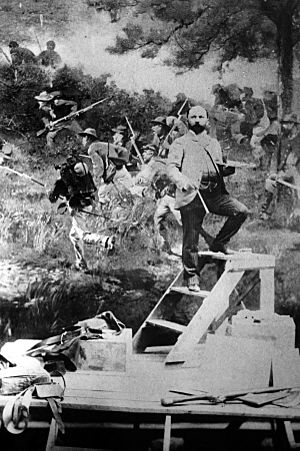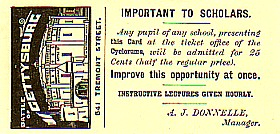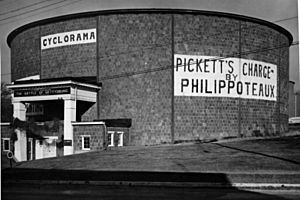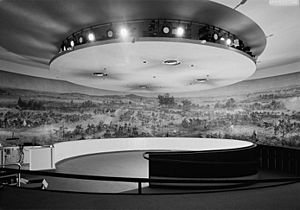Gettysburg Cyclorama facts for kids
Quick facts for kids The Battle of Gettysburg (detail) |
|
|---|---|
 |
|
| Artist | Paul Philippoteaux |
| Year | 1883 |
| Medium | Oil on canvas |
| Dimensions | 13 m × 115 m (42 ft × 377 ft) |
| Location | Museum and Visitor Center, Gettysburg National Military Park, Gettysburg, Pennsylvania |
The Battle of Gettysburg, also known as the Gettysburg Cyclorama, is a giant circular painting. It was created by the French artist Paul Philippoteaux. The painting shows a key moment from the Battle of Gettysburg on July 3, 1863. This moment is called Pickett's Charge, a big attack by the Confederate soldiers against the Union forces.
Contents
What is the Gettysburg Cyclorama?
This amazing painting was made by Paul Dominique Philippoteaux. It shows Pickett's Charge, which was a major attack during the Battle of Gettysburg. A cyclorama is a special type of painting that wraps all the way around you in a circle. It's like a 360-degree view!
The goal of a cyclorama is to make you feel like you are right there in the scene. To make it even more real, artists often add models and life-sized objects in front of the painting. This helps to create an amazing illusion.
The painting shows important places like Cemetery Ridge, the Angle, and the "High-water mark of the Confederacy". The original painting was 22 feet (6.7 m) tall and 279 feet (85 m) around. The version you can see in Gettysburg today is 42 feet (13 m) high and 377 feet (115 m) around. This version was restored in 2005.
Close-up Views of the Painting
Here are some detailed parts of the painting:
How the Painting Was Made
Paul Philippoteaux was very interested in cycloramas. He had already created other large circular paintings. In 1879, a group of investors from Chicago asked him to paint the Gettysburg Cyclorama.
Philippoteaux spent several weeks in April 1882 at the Gettysburg Battlefield. He sketched and took photos of the area. He also spent months researching the battle and its events. He even built a wooden platform to help him draw the scene accurately. Local photographer William H. Tipton took many photos that helped Philippoteaux create the painting.
Philippoteaux also talked to several soldiers who survived the battle. These included Union generals Winfield Scott Hancock, Abner Doubleday, Oliver Otis Howard, and Alexander S. Webb. Their memories helped him make the painting very realistic.
Philippoteaux worked with a team of five assistants. It took them over a year and a half to finish the huge painting. The completed work was almost 100 yards long and weighed six tons! When it was first shown, it included not just the painting, but also real objects like stone walls, trees, and fences. People said it was like the 19th-century version of an IMAX movie.
The Chicago Version
The first version of the Gettysburg Cyclorama opened to the public in Chicago on October 22, 1883. People loved it! General John Gibbon, a Union commander who fought in Pickett's Charge, said it was very good. Many veterans of the war reportedly cried when they saw it because it was so real.
This version was shown in Chicago in 1883 and again at the World's Fair in 1893.
The Wake Forest University Version
For a long time, people thought a painting owned by Wake Forest University was the original Chicago version. However, new research suggests it's a different copy. This copy was made around 1905, using Philippoteaux's drawings, but by other artists from his studio.
The Boston Version
The Chicago painting was so popular that another businessman, Charles L. Willoughby, asked for a second version. This one opened in Boston, Massachusetts, on December 22, 1884. From 1884 to 1892, about 200,000 people came to see it.
The Boston version was in a special building called the Cyclorama Building. People often gave talks there about the battle. Two more copies of the cyclorama were made after this. One opened in Philadelphia in 1886, and another in Brooklyn, New York, in 1886.
Many people felt the painting was incredibly real. One newspaper said it was "impossible to tell where reality ends and the painting begins." A veteran once pointed at the painting and told his friend, "You see that puff of smoke? Just wait a moment till that clears away, and I'll show you just where I stood." In New York, police once thought the dummies of dead soldiers in the exhibit were real burglars!
In 1891, the Boston cyclorama was temporarily swapped with another painting. When it came back in 1892, it was stored in a large crate. It got damaged by weather, vandals, and even two fires.
Later, in 1910, Albert J. Hahne bought the damaged painting. He showed parts of it in his department store in Newark, New Jersey. Sections were also shown in government buildings in New York City, Baltimore, Maryland, and Washington, D.C.. In Baltimore, George E. Pickett's widow, "Sallie" Pickett, gave talks about her husband's experiences and was very moved by the painting.
In 1912, a new cyclorama building was started in Gettysburg on Cemetery Hill. It opened in 1913, just in time for the 50th anniversary of the battle. The painting was once again shown as a full circle. However, the building was not heated and leaked, which further damaged the painting.
The National Park Service bought the Boston cyclorama in 1942. It was moved to a new Visitor's Center in 1961 after being restored a second time.
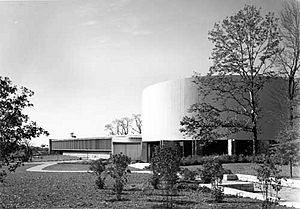
The exhibit stayed open until 2005, when it closed for a third major restoration. This restoration cost $12 million. Experts carefully put the painting back into its original shape. They even found some original pieces that had been cut away! They also restored 14 feet of the sky part of the painting.
A new building was built to house the restored painting. This is the new Gettysburg Museum and Visitor Center. It's located away from where the actual fighting happened in 1863. The restored Cyclorama opened to the public again in September 2008. The old Cyclorama building was taken down in 2013, and the area was returned to how it looked during the war.
Images for kids
-
Former Cyclorama building in Ziegler's Grove. The building was demolished in March 2013.











